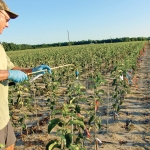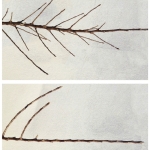A team of university researchers from the Northeast has developed a program that allows orchardists and nurseries to create highly feathered trees they think are essential in order to reap early profits from expensive high-density orchards.
The growth regulators can be used either in the nursery or on young trees in the orchard.
In the nursery
The protocol involves treating the growing tip of young apple trees with multiple sequential applications of either MaxCel (6-benzyladenine or 6-BA) or Promalin (a combination of 6-BA plus gibberellic acid or GA4/7), both products of Valent BioSciences.
Treatments begin when trees measure about 38 to 40 inches from the ground to the growing tip. Treatments are applied to the growing tip at every 5 to 7 inches of new growth (about two-week intervals). Each treatment induces buds to break at the point of application, with feathers appearing within two weeks.
Win Cowgill, professor and area fruit agent from Rutgers, the State University of New Jersey, presented the recommendations at the Mid-Atlantic Fruit and Vegetable Convention in Hershey, Pennsylvania, in January.
Cowgill conducted multiple experiments to determine effectiveness and rates at Adams County Nursery’s growing site in Milton, Delaware, working for the past three years in collaboration with other researchers. Similar trials were conducted elsewhere.
University of Massachusetts’ Wesley Autio and Jon Clements conducted similar experiments in Massachusetts, as did Cornell University’s Terence Robinson in New York, Washington State, and Chile. The work was supported by the International Fruit Tree Association and Northwest Nursery Improvement Institute.
Research began after it became clear that Tiberon (cyclanalide), a plant growth regulator that nurseries began using in 2009, was going to be withdrawn from that market by its manufacturer, Bayer Corporation.
In the research, Cowgill applied 4 milliliters (about 1/7 ounce) of liquid to the growing tip of each tree using a backpack sprayer calibrated to deliver that amount.
“Both MaxCel and Promalin are very effective in inducing branching on the varieties we tested,” Cowgill said. The number of feathers varied with the number of applications.
Cowgill believes that five applications would be a suitable number in areas with somewhat longer growing seasons, such as the Mid-Atlantic states, since the trees grow taller. Areas north of there may need fewer applications. In warmer areas, he says, 400 parts per million (ppm) of MaxCel applied four or five times should produce a good quantity of feathers. In cooler areas, 500 ppm may work better. The MaxCel label calls for 500 ppm.
Three applications of the MaxCel treatment on Macoun trees produced 15 to 18 branches, he said, compared to 10 to 11 with Tiberon and two to four on untreated trees.
On Golden Delicious, either Promalin or MaxCel applied at 500 ppm produced 17 to 20 branches, compared to about nine on untreated trees. Untreated tree shoots were longer, about 8 inches, compared to 5 to 6 inches on treated trees.
“For most varieties, our recommendation is MaxCel at 400 ppm, with no added surfactant, given in four to five applications beginning at 35 inches of tree height and repeated at 10- to 14-day intervals (after 5 to 6 inches of new growth),” Cowgill said.
“For Macoun, we recommend Promalin at 400 to 500 ppm plus 0.125 percent Regulaid.”
There was more phytotoxicity from MaxCel than from Promalin in the 2012 research. “Our later research trials concluded that surfactant should not be added to MaxCel for branching in the nursery,” Cowgill said. “It is pretty clear that the additional phytotoxicity was caused by adding extra surfactant to the MaxCel, which already contains a substantial package of proprietary surfactants in the formulation.”
In mixing the growth regulators, Cowgill made a solution containing 500 parts per million of either MaxCel or Promalin and adding one pint per 100 gallons (0.125 percent) of the non-ionic surfactant Regulaid. Cowgill says that when using MaxCel, no additional surfactant should be added.
Trees treated with Promalin were always taller than those treated with MaxCel in three years of trials. MaxCel inhibits shoot lengthening, an effect apparently countered by the gibberellic acid component in Promalin.
In the orchard
Many times growers do not get feathered trees from the nursery or they do not continue to feather the first and or second year.
“MaxCel and Promalin can be used to branch 1- to 2-year-old apple trees that do not have adequate feathers with several different methods,” Cowgill said.
First, if there is green tissue, trees can be sprayed with MaxCel or Promalin (up to 500 ppm) to break adequate feathers.
Second, if there is bare wood on the leader, trees can be notched right above the bud (right at bud swell) to induce that bud to break and generate a feather.
Third, the Promalin label allows painting the buds and wood before bud break to induce feathering.
Last year, Clements tested MaxCel mixed into white indoor latex paint at the labeled rate of 5,000 ppm. He applied it with a foam brush to areas where branching was desired after buds began to swell but before bud break.
“It appears the latex application was very effective at breaking branches compared to the untreated trees,” Clements said.
The MaxCel label allows for 5,000-7,500 ppm (0.2-0.33 pint of MaxCel per pint of latex paint). •
ONLINE
For more details see the two articles from Win Cowgill of Rutgers and Jon Clements of University of Massachusetts in Horticultural News at www.horticulturalnews.org/94-3/abcCover94-3.html








Leave A Comment